types of edible mushrooms
Mushroom hunting is a rewarding way to get outside and learn more about nature. There are many different edible mushrooms in the United States, including tasty chanterelles and morels.
Mushroom hunting can also be quite dangerous – many mushrooms are very similar in appearance. It’s easy to accidentally gather the wrong mushrooms, with devastating (or even deadly) consequences. When in doubt, throw the mushrooms out.
It’s best to learn about mushroom hunting and identification from an expert (or at least a detailed mushroom guidebook). Don’t just skim through a few photos and go out to sample the ‘shrooms – be thorough about your research into lookalikes, defining characteristics, collection, and storage.
Using staining and examining spores might be necessary to properly identify edible mushrooms – that’s why it’s important to get help!
Without further ado, let’s take a look at some of the common (and tasty) edible mushrooms of the United States!
#1: Morel Mushrooms (common edible mushrooms )

Range: Found across much of the U.S., especially under hardwood trees in orchards, burn areas, and disturbed grounds.
Harvest Season: A short time in springtime – exact window varies based on location.
Identifying Characteristics: Distinctive “honeycombed” cap, deeply wrinkled and yellow-grey. Hollow through the center. 2 to 9 centimeters tall by 2 to 5 centimeters thick.
Dangerous Lookalikes: Few edible mushrooms share the same honeycombed top. When in doubt, throw ’em out.
Preparation: Strong taste, best cooked in butter and often paired with leeks.
#2: Chanterelle (Cantharellus cibarus and more than 15 other species)
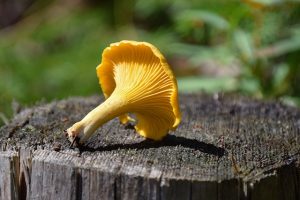
Range: Found across North America, Eurasia, Central America, and Africa, mostly in coniferous forests (but may be found in grasslands, mountainous birch forests, or beech forests depending on the location and specific species). They generally grow in clumps among the moss.
Harvest Season: Late summer through December, depending on the area and species.
Identifying Characteristics: Yellow or golden mushrooms, funnel-shaped, and meaty. Under the cap run gill-like ridges that run down the stem. Chanterelles may smell fruity, woody, or earthy.
Dangerous Lookalikes: The false chanterelle is darker (almost orangeish) and has a darker center that grades out towards light edges. It’s not dangerous, but tastes bad and might upset your stomach. Jack-o-lantern mushrooms can be confused for chanterelles. The gills of a jack-o-lantern mushroom are much thinner, deeper, and delicate than the smooth, blunt, and shallow gill-like ridges of a chanterelle. Jack-o-lantern mushrooms are toxic.
Preparation: Chanterelles often have a mildly peppery taste. They’re quite rich and often cooked with butter, wines, or creams.
#3: Fairy Ring edible mushrooms (Marasmius oreades)
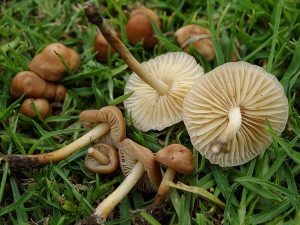
Range: Widely distributed across North America. Prefers to grow in grassy areas such as lawns, fields, or even dunes. They often grow in the craters where stumps used to be.
Harvest Season: Summer and fall, may grow year-round in warm climates.
Identifying Characteristics: These small mushrooms grow in a ring or arc. The cap is generally 1 to 5 centimeters across. When young, the cap might be slightly inrolled but it becomes upturned as the mushroom matures. The cap is sometimes described as nipple-like, with a prominent center. The fairy ring mushroom is dry and bald, generally a pale tan or buff (but may be white). The stem is very tough (this is one of the most reliable identification characteristics for this edible mushroom) and may or may not be attached to the gills. The spore print will be white.
Dangerous Lookalikes: Clitocybe dealbata is similar but does not have a tough stem. The gills are much more crowded than the fairy ring (which has well-spaced gills).
Preparation: Remove the stem, leaving the cap intact. Rinse with cold water if needed, then let dry. They don’t have a strong taste, so use more basic recipes to let their flavor shine.
#4: Sweet Tooth, Wood Hedgehog, or Hedgehog Mushroom (Hydnum repandum)
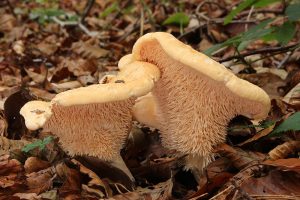
Range: Widely recorded in North America, Europe, Australia, and northern Asia.
Harvest Season: Summer and fall.
Identifying Characteristics: The wood hedgehog has spines or teeth on the underside of the cap rather than ridged gills – these are the defining characteristic of the species! Viewed from above, it is similar in shape to a chanterelle (but is pale orange-ish tan rather than golden in color). This edible mushrooms bruises dark orange or yellowish brown. The cap is varied in shape, generally broadly convex and 2 to 17 centimeters across.
Dangerous Lookalikes: No poisonous lookalikes, though this species may be confused with related North American species Hydnum albidum and Hydnum albomagnum.
Preparation: The wood hedgehog has a sweet and nutty taste. It’s crunchy and can be frozen.
#5 Meadow Mushroom or Field Mushroom (Agaricus campestris)
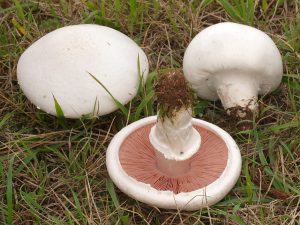
Range: This species is found across North America, Europe, Asia, northern Africa, and New Zealand. It’s generally found in grassland and may grow alone or in a “fairy ring.”
Harvest Season: Spring, summer, or fall after rain.
Identifying Characteristics: The meadow edible mushrooms has a white cap that’s 5 to 10 centimeters across. The cap is flat when the mushroom is mature. Underneath the cap, you’ll find pink gills in young mushrooms, reddish-brown in juvenile mushrooms, and dark brown gills in mature mushrooms. The stipe (stalk) is 3 to 10 centimeters tall. The flesh of the mushroom bruises to a reddish brown color and the spore print is dark brown.
Discard any specimens that do not have the distinct pink gills. Take extra caution with white mushroom species – there are fatal lookalikes.
Dangerous Lookalikes: This species is closely related to several species – some are deadly, others are edible. Amanita virosa is deadly and resembles the meadow mushroom when it’s young. Just one cap is enough to kill a person. The gills of the deadly Amanita virosa are white, as is the spore print. Amanita bisporigera and Amanita ocreata are also toxic lookalikes found in North America. A. ocreata can be identified by whitish gills and white to pinkish fruiting bodies. A. bisporigera also has white gills. These mushrooms are some of the most poisonous known mushrooms and cause liver failure. They’re collectively known as “destroying angel mushrooms.”
Other lookalikes include Agaricus xanthodermus, which causes gastronomical upset and can be identified by a yellow stain that appears in the stipe (stem) when cut, and Agaricus arvensis, which is also edible. Agaricus arvensis has white gills (like the deadly Amanita virosa) when young, but they become a dull chocolatey color in adulthood. Agaricus arvensis often smells similar to anise. These lookalikes highlight the reason that it’s so important to get help from an expert when learning to identify mushrooms!
Preparation: This mushroom tastes much like the button edible mushrooms, but has a shorter shelf life. It’s tasty when sauteed, fried, or even raw on salads.
#6 Shaggy Mane Mushroom, Lawyer’s Wig, Shaggy Inkcap, or Maned Agaric (Coprinus comatus)
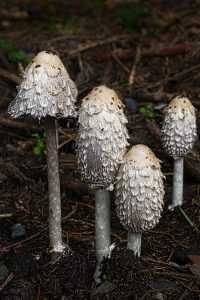
Range: Grasslands and meadows across North America and Europe.
Harvest Season: June through November, depending on temperature.
Identifying Characteristics: This species is only edible when immature – before the gills turn black. It’s got a shaggy cap that droops over much of the stem when young and is covered in loose scales. The gills rapidly turn from white to pink to black. This species must be harvested before the gills turn black.
Dangerous Lookalikes: The maned agaric can be confused with the common ink cap, which can induce vomiting, diarrhea, and other unpleasant symptoms if eaten within a few hours of consuming alcohol. The symptoms can be frightening but will subside without further consumption of alcohol. The severity of these symptoms is generally proportional to the amount of alcohol consumed.wild edible mushrooms
Preparation: This edible mushrooms carries lots of water, making it a good addition to soups and stocks, including risotto.
#7 Hen of the Wood, Ram’s Head, Sheep’s Head, Signorina, or Maitake (Grifola frondosa)
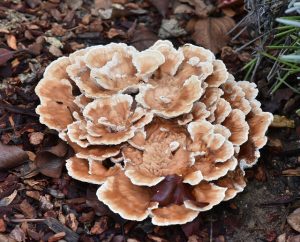
Range: This mushroom is found at the base of trees, especially oak trees in China, Japan, and northeastern North America. It has been reported as far west as Idaho.
Harvest Season: Late summer to early autumn after rain. This is a perennial mushroom that often grows in the same place year after year, but only for very short lifespans.
Identifying Characteristics: This tuber-like mushroom grows in a large clump that some describe as coral-like. The caps are greyish-brown that are curled or spoon-shaped. The mushroom can grow up to 100 pounds in Japan, but is often much smaller. Stipes (stalks) are white and branching. They become quite tough as the mushroom ages.
Dangerous Lookalikes: There are no toxic lookalikes to the Hen of the Woods, but it may be confused with Meripilus giganteus, which is also edible. M. giganteus is thicker and stains black along the edges.
Preparation: Harvest with a knife – cutting this mushroom requires a large one. Harvest when the mushroom is young for best flavor and texture. This edible mushrooms is common in Japanese cuisine and is tasty sauteed in butter or olive oil, or as part of many dishes.
#8 Bear’s Head Tooth, Monkey’s Head, Pom Pom, Bearded Hedgehog, or Lion’s Mane Mushroom (Genus Hericium)
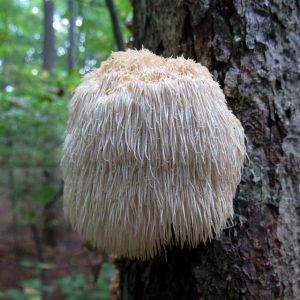
Range: These species are found across the world, particularly in the north in alpine forests or deciduous forests. Like many other edible mushrooms, they grow well in shaded areas on rotten logs.
Harvest Season: Autumn.
Identifying Characteristics: This mushroom may resemble hundreds of tiny icicles dangling from a log or from the sturdy stalks of the mushroom. It’s quite distinctive. All white parts of the mushroom are edible.edible mushrooms
Dangerous Lookalikes: All four species found in North America are edible. Dangerous lookalikes may exist in other parts of the world.
Preparation: Cook in butter or use in soups later in the winter.
#9 Giant Puffballs (Calvatia gigantea)
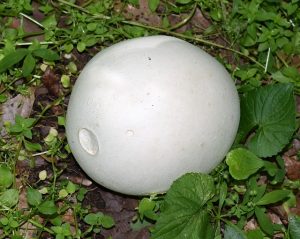
Range: The giant puffball is found in temperate areas around the world, mostly in meadows, fields, and deciduous forests.
Harvest Season: Late summer to early fall.
Identifying Characteristics: Giant puffballs generally grow 10 to 50 centimeters across, though they reportedly can grow up to 150 centimeters across! The inside of a mature giant puffball is greenish brown. They’re edible when young, when the inside flesh is white rather than greenish brown. They’re dangerous to eat when mature!
Dangerous Lookalikes: All true puffball species are edible when young but toxic in adulthood. Cut them open to ensure they’re white before eating. The trouble is that puffballs may resemble many other species of mushroom when young, including some very toxic species. To tell them apart, cut the edible mushrooms open. Puffballs will have a solid white interior, while lookalikes may be other colors. Other toxic lookalikes have a white interior but show the silhouette of a cap or gills when cut – ensure that these are absent before eating.mushrooms that are edible
Giant puffballs may also be confused with earthballs, particularly in the U.K. Earthballs are darker on the inside early in development – but may still be white when young. The skin of an earthball is firm and punctuated with wartlike bumps. Ensure that the puffball is smooth, has a stem, and is white before eating. When in doubt, throw it out!
Preparation: Do not wash – this fungus will soak up water. They can be stored for a few days in the refrigerator without losing much quality.edible wild mushrooms
#10 Sulphur Shelf Mushroom or Chicken Mushroom (Laetiporus sulphureus)
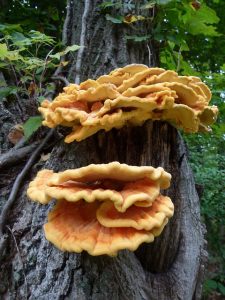
Range: Grows on dead or adult oak trees and several other species of hardwood, especially east of the Rocky Mountains.
Harvest Season: Generally summer, but can be found spring through summer if the climate is right.
Identifying Characteristics: This bracket mushroom does not have gills. It’s large and orange or salmon-pink on top, with a bright yellow underside. They grow in clumps along a variety of trees – primarily oak. Be sure you can identify the host tree accurately.
Dangerous Lookalikes: This species might be dangerous to eat if growing on certain trees, if eaten when it’s old, or improper cooking. Taste small, young, well-cooked bits before digging in. Specimens growing on several species of tree (pine, juniper, spruce, hemlock, eucalyptus, locust, fir, or tamarack) are particularly suspect – avoid them. If you can’t identify the tree for sure because it’s dead, play it safe and skip the ‘shroom. Sulphur shelf mushrooms growing on the tree species listed are actually a different, toxic, species.list of edible mushrooms
Preparation: Only the young caps of this edible mushrooms are soft enough to cook – don’t bother with the tough stem or older specimens. They’re known for a rich, meaty flavor.

Range: Across North America, especially in mossy hardwood forests (oak and beech are favorite neighbors). They often grow near washes and streams, preferring damp and dark areas.
Harvest Season: Summer and fall, through the winter in southern areas.
Identifying Characteristics: These mushrooms grow in leaf litter and can be very hard to spot. They grow in clusters, though, so if you find one, you’re in luck! The cap of this mushroom is inky black, dark brown, or grey and vase- or trumpet-shaped. The underside is smooth with no gills, pores, or teeth. The top of the cap might have small scales, but the texture overall is smooth or slightly wrinkled.
Dangerous Lookalikes: None – this species is a good one for beginning foragers! The black urn mushroom is cup-shaped and not poisonous, but definitely not tasty!
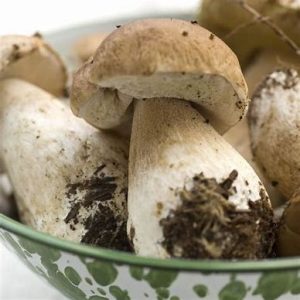
Preparation: These edible mushrooms have a rich, smoky flavor. Wipe clean, as they’re often quite dirty. A quick rinse is ok, but don’t drown them! They hold their flavor well if dried. They’re delicious sauteed with garlic and oil, or powdered on soup or grains.
When it comes to edible mushrooms hunting, be sure to keep the Dunning-Kruger effect in mind. This effect reminds us that we often have high confidence in our skills when our skills are in fact low, and only become humble when we realize how complicated something is!

Be sure to get help from an expert and use gills, spore prints, and cuttings to identify mushrooms properly. There may be some dangerous lookalikes in your area, so local expertise is a must!


